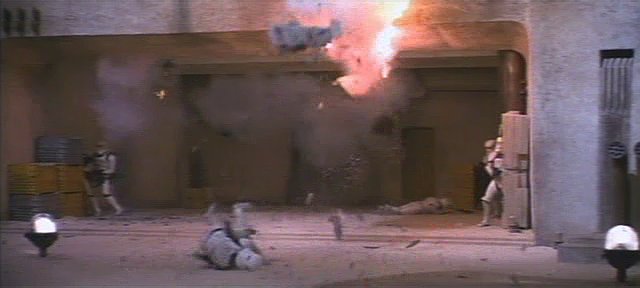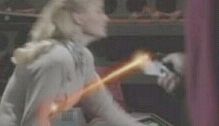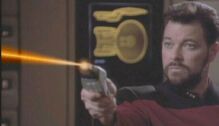A Couple Words on Blaster Firepower
 |
| [Editor's note: RSA says "I'd rather use bullets, thanks." Perhaps he didn't notice the torso-sized chunk of ferrocrete being blasted out of the wall by Solo's blaster] |
This is arguably the weakest of Mr. Anderson's pages, but it demonstrates several trends quite well. Anderson, in this page, marginalizes his critics without actually answering their points, and ignores canonical evidence to support his strange views. Anderson showcases several screenshots of Princess Leia being fired on in RotJ. The blaster burns her arm, but does little damage. He then goes on to claim that the shot is representative of blaster firepower in SW by stating that he would rather fire bullets than blaster shots. This is reasonable, from this particularly isolated example, but additional images from the movies clearly disprove his basic premise.
In the Mos Eisley space port, weapons fire from Han and the stormtroopers clearly does significant damage to the walls of the space port, which are doubtless designed to resist the effects of a spacecraft lifting off and using its main engines. Note that the exhaust of a ship in Star Wars must be significant, due to the canonical use of blast-doors around the Death Star's hangars in ANH. The shots fired knock fairly large chunks from the wall, and clearly demonstrate a firepower well in excess of what Mr. Anderson claims, despite his statement that:
"the highest end is hardly better. After all, we know how easy it is to penetrate Stormtrooper armor, and we've seen the similar amount of damage a blaster did to Luke's artificial hand. "
Anderson deludes himself once again. Here he appears to assume that the ability of a substance to resist energy in the form of heat is equivalent to its ability to resist impacts of other objects. He also argues that Luke's artificial hand, made of a completely unknown material, is a good benchmark with which to prove his point about blaster fire.
"A quote from the novelization of ANH, chapter 1, during the boarding of Leia's vessel: "Red, green and blue bolts ricocheted off polished sections of wall and floor or ripped long gashes in metal surfaces."
"Ricocheted off polished sections of wall"? Wouldn't that suggest that a mirrored surface would be undamaged? Alas, this seems to be overruled by the hits to the mirror-finish royal yacht in TPM . . . but, then, those were not hand blasters. Hmmm. "
Anderson's speculation here totally ignores canonical incidents, which include hand blaster fire being deflected by utterly non-reflective surfaces. In fact, during the Battle of Naboo in TPM, a blaster bolt fired from a blaster carbine prominently deflects off of the ground. Also, stormtrooper armor is also reflective but is canonically seen to provide minimal protection from blaster fire. Anderson's statement is clearly an attempt to cast doubt on the effectiveness of Star Wars weaponry, despite what is observed in canon. This is clearly an example of intellectual dishonesty.
Apparently, some unaccredited source demonstrated that in one instance, a phaser did approximately the same amount of damage to Doctor Crusher when she was hit by such a weapon. Anderson excuses this in part by explaining:
"there's the simple fact that the beam Lore shot Crusher with was one of the wimpiest seen out of early TNG phasers."
This is another self-contradiction. Anderson has stated elsewhere that the intensity and width of a beam weapon has little impact on its firepower, to prevent "rabid Warsies" from using an example of a Mon Calamari cruiser firing a turbolaser that is a few hundred meters long and claiming that it demonstrates proportionately greater firepower than was observed in the ESB asteroid scene.


"And yet, here we have off-axis firing ability, either making up for bad aim or being proof that the weapons are as aimable as one likes. Given the off-axis firing ability, we thus either have a manually-selected user option which allows for firing off at a certain angle, or else we have a highly advanced auto-aiming system in use. "
This demonstrated property of phaser fire is not impressive, and even appears to be somewhat detrimental in the screen-shots that Mr. Anderson has presented us with. The final picture shows Riker firing his phaser at a woman in "Vengeance Factor" [TNG]. He appears to be aiming at her head, and she appears to be only a few meters away from him. The off-axis firing of the phaser, however, discharges the weapon towards her chest, and it impacts the side of her abdomen. Anderson's speculation about an auto-aiming system is further disproved by his own screen-captures. Had the weapon been designed to fire at the center of the target's chest, Riker's shot from "Vengeance Factor" would have hit Yuta further right of where it did. Moreover, Lore's shot (about which this entire page is written) demonstrates that the shot missed and hit Dr. Crusher in the arm. It is difficult to accept that Data's more advanced brother would have missed so badly while using a weapon with such an advanced auto-aiming system, but we clearly see the shot miss wide.
"Of course, given the phaser's ability to fire in a widebeam mode, off-axis firing should not be a surprise. "
Why should such a capability be expected from a weapon that provides wide-angle firing capabilities are highly suspect. Consider a flashlight with adjustable width. It can be set for "wide angle," but clearly cannot redirect the beam to another axis. The phaser's off-axis firing capabilities are demonstrated by the screen-captures Mr. Anderson has on his site, but this ability is a detriment rather than a strength.
[Editor's note: it should also be noted that those hand phasers may simply have a fixed off-axis downward angle. There are no "iron sights" or even a gun barrel, so aiming is done through sheer practice rather than sighting down a barrel and there's really no advantage or disadvantage to having the phaser always fire on a 20 degree downward slant, for example (in fact, it would actually be easier on the wrist, given the odd handgrip). Besides, we've seen the controls on a hand phaser in "Vengeance Factor" and the only control is a power setting, so how can this thing possibly be configured to aim at certain targets? How does it know which target to shoot at, and how to tell friend from foe? And what's the point of the marksmanship practice we saw in TNG if the phaser does most of the aiming by itself? The "phasers can auto-aim" argument is one of the silliest out there, but it still crops up from time to time, and it should come as no surprise that RSA uses it despite its glaring weaknesses because if any pattern is abundantly clear, it is that he can and will say anything if he feels it helps his side].